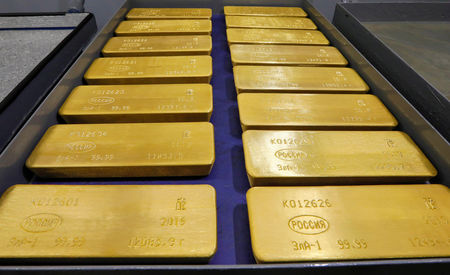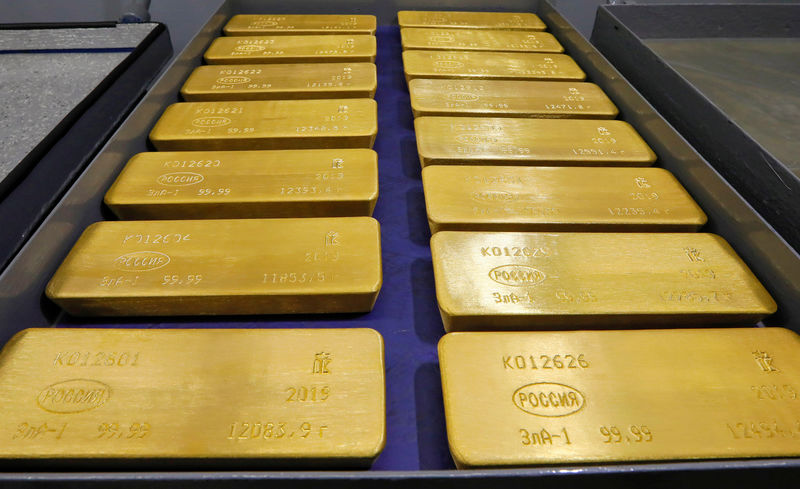Commodities
Gold prices steady with US labor data, rate cut bets in focus


© Reuters.
Investing.com– Gold prices moved little in Asian trade on Thursday as traders hunkered down in anticipation of more cues on a cooling U.S. labor market, while focus also remained on when the Federal Reserve planned to begin trimming interest rates.
The yellow metal appeared to have settled into a trading range of between $2,020 and $2,050 an ounce after briefly surging to record highs above $2,100 at the beginning of the week.
A string of different factors had spurred gold’s rally, as seemingly dovish cues from Fed Chair Jerome Powell pushed up expectations that the Fed will cut rates by as soon as March 2024.
But markets tapered these expectations over the week, especially amid some signs of resilience in the U.S. economy.
Increased safe haven demand, following an attack on U.S. vessels in the Red Sea, also aided gold prices, although a lack of any escalation in the Middle East saw tensions ebb out of markets.
steadied at $2,026.30 an ounce, while expiring in February fell 0.2% to $2,043.05 an ounce by 00:24 ET (05:24 GMT).
Nonfarm payrolls in focus as markets speculate over Fed cuts
Traders were now focused squarely on data for November, due on Friday, for any more cues on the labor market.
and data released earlier this week signaled some cooling in the U.S. labor market. But markets were awaiting definitive signals from the nonfarm payrolls reading.
The reading is also due amid growing uncertainty over the timing of the Fed’s interest rate cuts. While the central bank is widely expected to , markets were uncertain over when it could begin loosening policy.
So far, Fed officials have shown little inclination to begin cutting interest rates, with Powell having recently reiterated his higher-for-longer stance. But traders are betting that a further cooling in inflation and the labor market will see the Fed change its tone in the coming months.
Gold is expected to benefit from any signals of a less hawkish Fed and a cooling labor market. The yellow metal has comfortably held the $2,000 level since late-November, which could herald more strength in the coming weeks.
Copper rebounds on positive China import data
Among industrial metals, copper prices rose sharply on Thursday, rebounding from three straight days of losses as data showed Chinese imports of the red metal surged to a two-year high.
expiring in March rose 0.7% to $3.7568 a pound.
China’s copper imports jumped 10.1% in November to 550,566 metric tons- their highest since December 2021. The data indicated that Chinese copper demand remained robust, even as other aspects of the economy slowed.
China’s overall unexpectedly shrank in November, while grew for the first time in six months.
Upgrade your investing with our groundbreaking, AI-powered InvestingPro+ stock picks. Use coupon INVSPRO2024 to avail a limited time discount on our Pro and Pro+ subscription plans. Click here to know more, and don’t forget to use the discount code when checking out!
Commodities
Oil prices rise; U.S. crude inventories plunge, Russia-Ukraine truce eyed
Commodities
India’s Reliance to stop buying Venezuelan oil over US tariffs, sources say
Commodities
Oil prices climb on Venezuela supply worries

 Forex3 years ago
Forex3 years agoForex Today: the dollar is gaining strength amid gloomy sentiment at the start of the Fed’s week

 Forex3 years ago
Forex3 years agoUnbiased review of Pocket Option broker

 Forex3 years ago
Forex3 years agoDollar to pound sterling exchange rate today: Pound plummeted to its lowest since 1985

 Forex3 years ago
Forex3 years agoHow is the Australian dollar doing today?

 Cryptocurrency3 years ago
Cryptocurrency3 years agoWhat happened in the crypto market – current events today

 World3 years ago
World3 years agoWhy are modern video games an art form?

 Commodities3 years ago
Commodities3 years agoCopper continues to fall in price on expectations of lower demand in China

 Economy3 years ago
Economy3 years agoCrude oil tankers double in price due to EU anti-Russian sanctions























